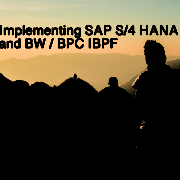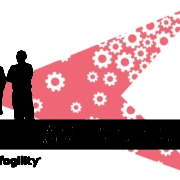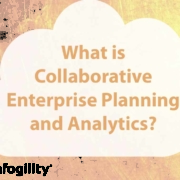S/4 HANA Central Finance Path to Advance Analytics and Planning
Over the years companies implemented SAP over a long period of time, meaning they have a combination of legacy and SAP environment to deal with, and that made it very difficult to have a common consolidate environment without having to create a data warehouse.
SAP made a strategic decision in 2015 to deliver a real-time consolidation solution based on SAP Business Planning and Consolidation version for NW on HANA with real-time consolidation; customers can get benefit of an integrated real-time consolidation in the context of Central Finance.
Central finance is also providing a roadmap to SAP Simple Finance, without disruption to your current system landscape, which can be made up of a combination of SAP systems of different releases and accounting approaches and non-SAP systems. This allow you to have a common consolidate environment including all your different system.
With the SAP Central Finance solution, it allows you to create a common reporting, consolidation and planning environment with integrated real-time information. With the Realtime data replicate a change to an FI-document from the source system it will update the corresponding FI-document in the Central Finance System.
You can also replicate cost objects (for example, production orders) to the Central Finance system. These represent the business transactions in logistics (for example, production, maintenance, and quality) and may not be at an appropriate granularity in the Central Finance system. For this reason, you can choose to transfer some cost objects, such as long-living internal orders, directly to orders in the Central Finance system and to map other cost objects, such as short-living production orders, to more long-living cost objects, such as a production cost collector in the central system.
Central Finance also improve the quality of existing traditional periodic consolidation solutions via sourcing from a single centralized and harmonized financial data repository.
Solution capabilities
- Finance process execution (finance, planning, consolidation)
- Replicate a change to an FI-document from the source system
- Universal Journal, as Single source of Truth
- One line item with all dimensions from FI,CO,AA,COPA, and Material ledger
- Harmonization of internal and external reporting
- Single (same) platform for transactions and analysis
- Enterprise KPI repository, digital boardroom
- Fiori user interaction / user experience
- Excel-based data queries and analysis – Analysis for office
- Enabling functions & features
- Inbound posting with customer extension for data digitization – Open items
- Error correction, reconciliation reporting, back-posting
How does this work?
- All the transaction in your standard SAP and NON-SAP system is translated into a universal document and central data model
- The SAP Replication Server collects data written to databases in the source systems and feeds this data into the corresponding Central Finance accounting interfaces.
- Data is mapped to a common Central financial data structure
- The internal accounting interface posts the Financial Accounting (FI)/Management Accounting (CO) document to SAP HANA as a universal Journal entry.
- Central Finance reporting provides common financial reporting allowing you to report on financial figures that originate in different source systems.

Prerequisites
Central Finance can be used out-of-the box with all SAP ERP releases that are still in maintenance starting from SAP ERP 6.0. Instructions on how to implement Central Finance with these systems are available either as SAP Notes or are contained in the support packages for these systems. For releases SAP R/3 4.6C to SAP ERP 5, contact SAP Product Management by creating an incident on the component FI-CF.
If you want to replicate your data from a system that uses a 3rd-party database with a runtime license, SAP strongly recommends that you use the Central Finance – Business Integration Scenario. For more information, see SAP Note 2223621Information published on SAP site.
SAP System Landscape Transformation Server (SLT) can be used to replicate data from most databases of non-SAP ERP systems. The field and structure mapping that is necessary to enable Central Finance interfaces to be filled can be carried out directly in SLT.
Licensing – Required Software
- Central Finance
- Contact your SAP Account Executive to verify if you need to purchase this license.
- SAP Landscape Transformation Replication Server
- Contact your SAP Account Executive to verify if you need to purchase a license.
- Licensing – Optional Software
- You have a license for Central Finance. Contact your SAP Account Executive to verify if you need to purchase this license.
- You have activated the Central Finance (FINS_CFIN) business function.
- You have activated the following business functions for error correction:
- Error Correction System (Reversible) (FIN_GL_ERR_CORR)
- Error Correction and Suspense Accounting (Reversible) (FIN_GL_ERR_CORR_SUSP)
- You have made the required settings for Central Finance in Customizing under Financial Accounting (New).
- You have installed SAP LT Replication Server. Contact your SAP Account Executive to verify if you need to purchase a license.
- SAP LT Replication Server is a database-oriented tool that can be installed as a separate system, or on top of any of the source systems or the Central Finance system. For more information, see the guides for the SAP LT Replication Server on the SAP HELP Portal at Start of the navigation path http://help.sap.comInformation published on SAP site Next navigation step SAP In-Memory Computing Next navigation step SAP HANA Next navigation step SAP HANA Options Next navigation step SAP HANA Real-Time Replication End of the navigation path.
- You have installed the following SAP notes in your source systems:
- 2111634Information published on SAP site
- 2108225Information published on SAP site
- 2115885Information published on SAP site
- You have ensured that the central system contains harmonized organizational data and master data for all the accounting entities that you intend to include in your accounting document.
Master Data Governance (SAP MDG)
Central Finance offers integration to Master Data Governance (MDG) to access available mapping information. If you use MDG to distribute master data throughout your system landscape. The MDG license is only required if the MDG application is used.

Even if MDG is not in use, in the background Central Finance uses the MDG mapping tables that are available without installing MDG. This does not require an MDG license.
Different types of master data are mapped in different ways:
- Master data, such as G/L accounts, customers, and vendors, must be either mapped manually as part of your Customizing or using SAP Master Data Governance.
- Master data relating to cost objects, such as production orders and internal orders, is mapped using the cost object mapping framework.
FI/CO Data replication
Replication Server SAP LT Replication Server collects data written to databases in the source systems and feeds this data into the corresponding Central Finance accounting interface.
Three replication scenarios are supported:
- Replication of FI postings
- Open Item replicated into Central Finance
- Replicate open item and automatically/technically clear in Central Finance Available as of 1503
- Continued open item management in source system
- Replicate open item and clearing status in Central Finance – please see note 2292043 Not suitable for central reporting or central processing (since clearing status not correct) Centralization of finance operations reporting and central process orchestration
- A/R and A/P reporting (cross-system view of customer or vendor account)
- Central Disputes, Collections, Invoice Management, Credit, Shared Services
- Replication of CO internal postings
- Replication of cost objects SAP LT Replication Server is also used for the initial load of CO internal postings and cost objects. The initial load of FI data is managed via Customizing activities in the Central Finance system.

Integrated Business Planning
SAP Simple Finance, (IBPF) can be combined with Central Finance to provide a common consistent view of planning across all environment.
- It eliminates data replication and have real time access to master in Central Finance using transactional data maintained in Central Finance for modelling and variance analysis.
- It enables flexible drill-down on drivers of profitability including customer, segment, product category, product, geography and channel
- It provides a Seamless integration of IBPF planning screens into Central Finance by replacing the current planning capabilities in OLD SAP ERP like Cost Center Planning, Profit center planning etc. It also enables Retraction of Plan data generated in SAP BPC to SAP ERP for variance analysis with the actuals.
- It Provides End-to-End simulation capabilities. If a sales manager enters planned sales/revenue, the same will be reflected in Profit and loss planning in IBPF.
- It offers Single Planning solution with strengths of IBPF, and an imbedded BW solution integrated with Central Finance which gives line item level drill down and single source of truth.
- It enables identification of trends, insight and forecasts using predictive analysis through SAP HANA
- It comes with pre-defined planning models for easy and quick adoption with various planning templates and BW/HANA content

Consolidations
Consolidation is a key SAP Finance value and core value proposition of Central Finance
Central Finance, from a consolidation perspective, provides for incremental improvement opportunities like
- Centralization of mapping / data harmonization across recording, reporting, planning and consolidation
- Interface landscape complexity reduction
- Business model change processing
- Merger and acquisition onboarding
Central Finance, from a consolidation perspective, provides for incremental improvement opportunities like:
- Centralization of mapping / data harmonization across recording, reporting, planning and consolidation
- Interface landscape complexity reduction
- Business model change processing
- Merger and acquisition onboarding
- Central Finance can also improve the quality of existing traditional periodic consolidation solutions via sourcing from a single centralized and harmonized financial data repository
- Support real-time soft close and analysis
- Data validation and preparation at source (initial entry)
- Unification of Planning and Consolidation solution
- Support for Consolidations, with data replication, on the Embedded Model -available with limitations
- Universal Journal based data model -next phase
- Additional functional enhancements including consolidation capabilities currently available in other SAP consolidation products -forthcoming
Reporting
- With all harmonized data on one integrated central environment it provides an Instant insight and improved decision making
- All SAP standard reporting tools can be leverage:
- Fiori-Reportingv – over ac 1000 tile avaialble
- Analysis for Office – Rerpoting of a central realtime integrated data model
- The centralized cockpit-like approach to viewing margin and performance that supports variance tracking to identify potential issues.
- The improved variance tracking helps you to isolate causes and ensure costs are being captured correctly in all processes and orders.
- Additional information helps you to analyze both overall and detailed costs to make sure actual production costs are close to target costs.
- Universal Journal, as single source of truth
- One line item with all dimensions from FI, CO ,AA ,COPA, and Material ledger
- Harmonization of internal and external reporting
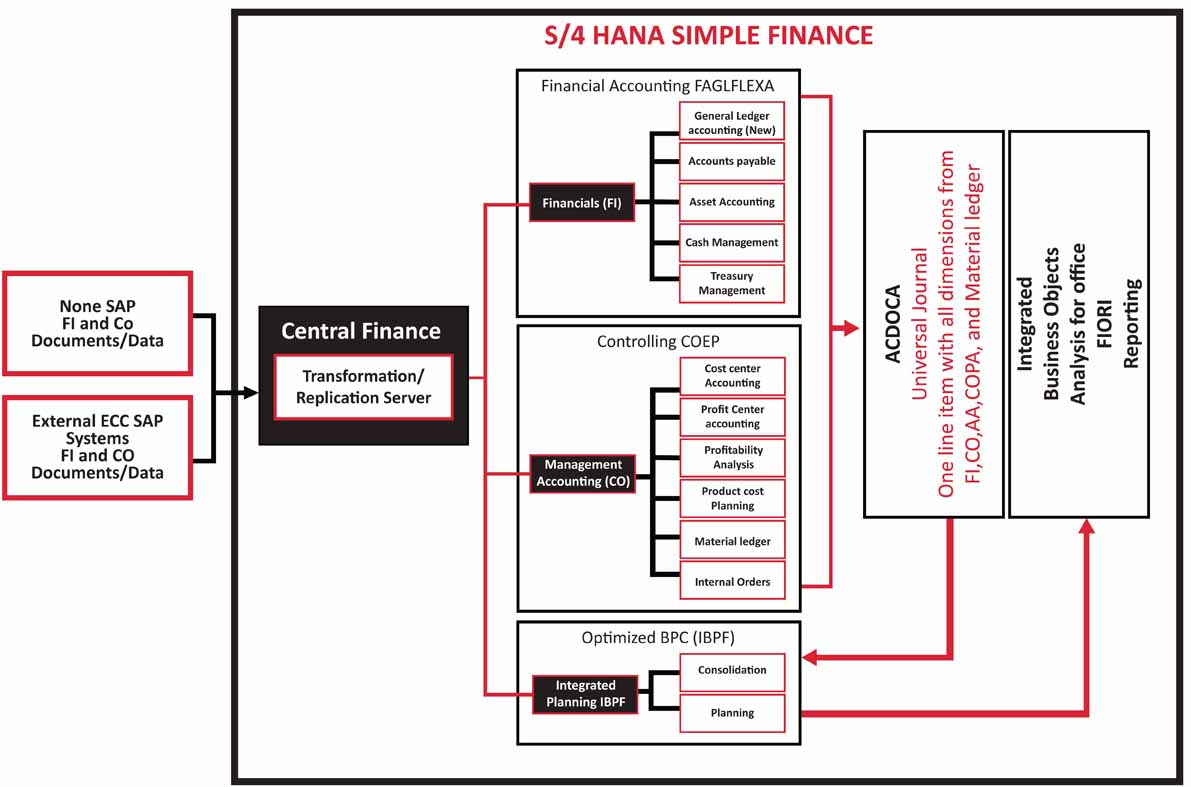
Integrated imbedded structure
SAP S/4HANA embedded analytics as the name suggests are part of the standard SAP S/4HANA installation and is used to perform real-time reporting and analysis on live transactional data. The key architectural components of SAP S/4HANA embedded analytics include the SAP HANA database, virtual data model, analytical engine (embedded SAP BW), OData service, and interfaces as illustrated below.
SAP BPC Embedded has been developed by SAP to give the Business function the flexibility that they need when planning, forecasting, consolidation and reporting, while the application is wholly integrated with BW, which means sharing ownership and maintenance of the application between the IT department and the Business function.
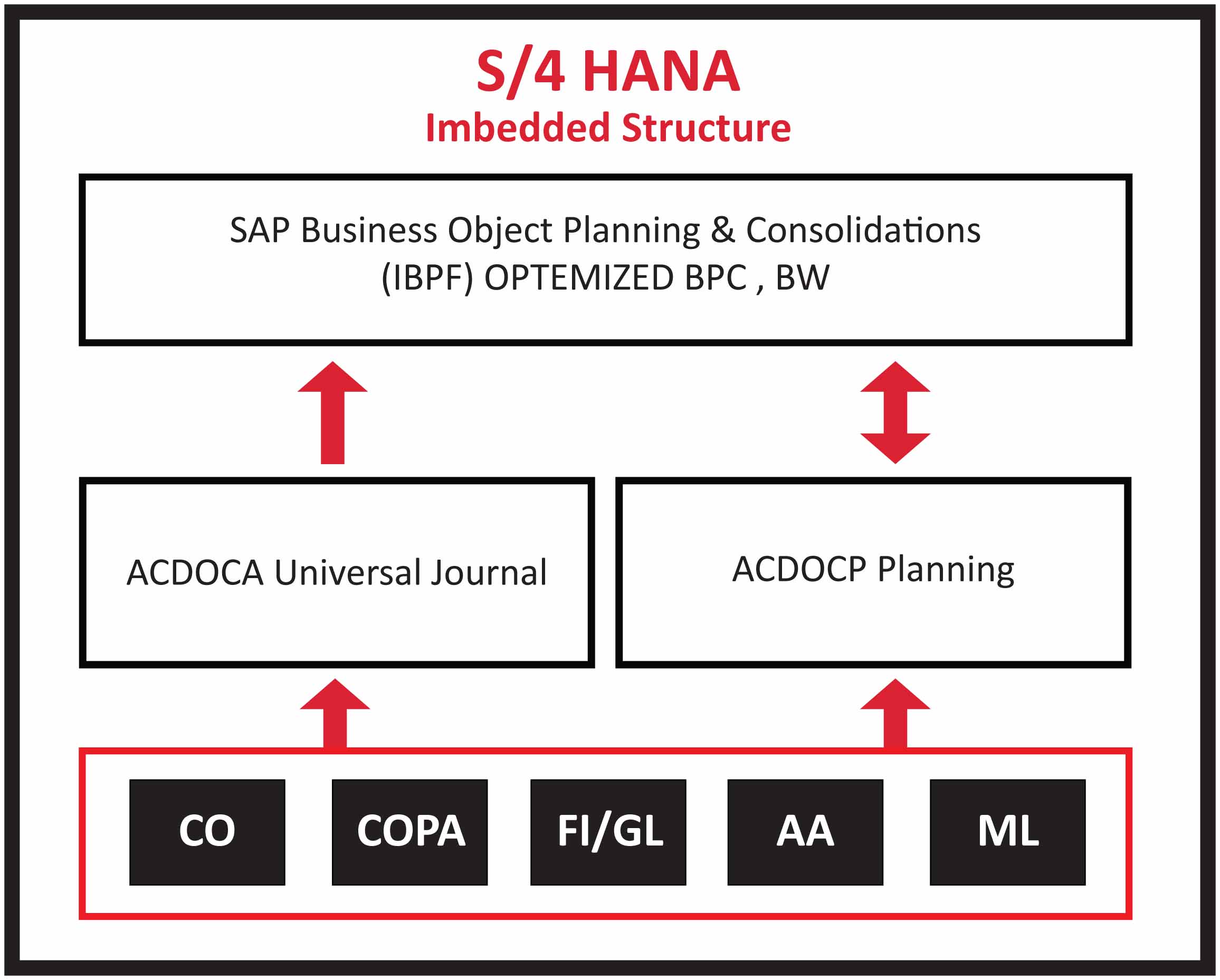
- Allows you to implement SAP without disrupting your existing source SAP ERP systems
- Can be used as a functional migration option, a flexible reporting platform for mergers and acquisitions, and a shared services system
- Master data management is handled by Master Data Governance (MDG)
- Improve process efficiency, self-service analytics
- Minimize manual processes, reduce costs for different processing methods
- Reduce cycle times / transaction cost, re-deploy labor to value-added activities
- Optimize resource allocation, realize cross-entity market potential
- Improve cash management, collections, and receivables
- Quickly adapt to changing business environments
- Align individual with corporate goals, establish single source of truth
- Integrated imbedded structure
- Fiori, HANA Live (or the new S/4HANA Analytics), SAP BW, and SAP BPC can all be integrated in real-time at the document level with financial controls and correction handling prior to posting via Application Integration Framework (AIF) functionality
- Consists of one document for real-time processing and analytics and merges FI and CO together into a “single source of truth” known as the “Universal Journal”
- Central Finance, the accounting interface is directly replicated to the Universal Journal which reduces the need for reconciliation, integration, batch processing and data replication
For more information on our services click here.


